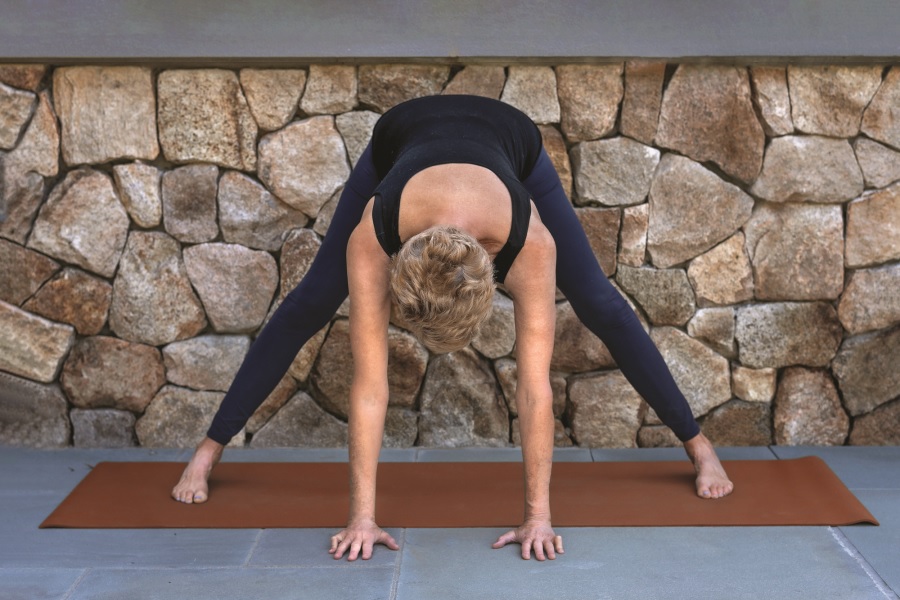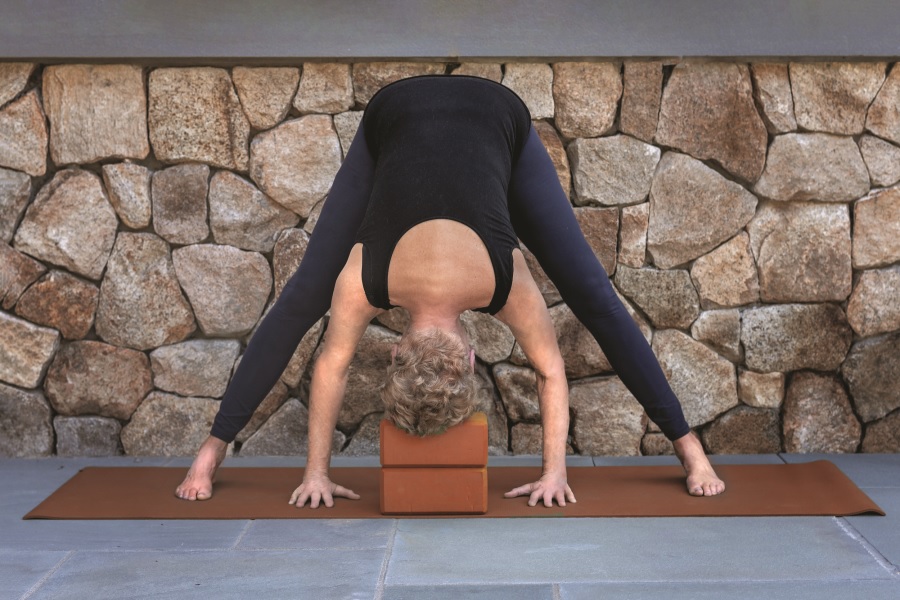I think of this newly becalmed time of year as right for reconnecting — with ourselves and with the world around us. And I turn to yoga for this. The practice of yoga is meant to connect us more deeply to ourselves as well as nature and beyond. The term “yoga” comes from the Sanskrit word yuj, which means to join.
There is a particular pose, a forward bend done with the legs planted wide apart, that I find encourages reconnection: Prasarita Padottanasana. As you practice this pose, you may have an experience of the interconnectedness of everything, at least within your body if not in the whole cosmos.
It helps that this pose engages the whole body. It strengthens the legs and feet. It also stretches your ankles, calves, hamstrings, groin, buttocks, and lower back. At the same time that it energizes the body, it calms the mind.

Prasarita Padottanasana is also an inversion, which can be energizing, but because it increases blood flow to the head, it is not advisable for people with uncontrolled high blood pressure or glaucoma or anyone who has had a detached retina.
Before starting the pose, imagine your body is like a Calder mobile: you touch one end and everything else smoothly moves in concert. Think of this standing wide-legged forward bend as allowing your interconnected parts to move freely.
To get in the pose, stand in the middle of your yoga mat or on a surface where you won’t slip. Begin in Mountain pose, feet parallel and hip-width apart. Take a breath, place your hands on your hips, and step your feet three to four feet apart as you exhale. You can experiment with the distance between your feet. You want your stance to be wide but to avoid straining the hip joints.
Bring your awareness to your feet. Lift and press into the balls of the feet, under your big toes and into your heels. Then press the outside edges of your feet into the ground, your feet fully engaged. Next, draw the muscles three inches below your navel in and up slightly and knit the ribs in to engage your core. Draw your tailbone down.
Notice that all of these are subtle actions. You should still be able to breathe comfortably. Take a moment to reach your arms over your head and lift out of your waist, lengthening the sides of your body.
To fold forward, put your hands in your hip creases (where your thighs meet your hips). Engage and lift your thighs and at the same time allow a tiny bend in your knees. Keep your back straight as you fold forward from the hips.

Reach your hands to the floor, shoulder width apart, arms straight. Be careful to come forward from the hip joints, not by rounding your lower back — that will strain your back. If you have trouble reaching the floor with your hands, yoga has a good solution for that: bring the floor higher up. You can do that by placing a chair in front of you so you’re placing your hands on the seat instead of on the floor. Make sure the chair is not going to slip as you lean into it.
You may also need to bend your knees more. Tight hamstrings can make it difficult to keep your legs straight as you come forward. In any case, don’t lock your knees.
From here, if you’d like to take the pose deeper, you may bend the spine to bring your head towards the floor and walk your hands back, keeping your elbows bent. If your head reaches the floor, gently rest the crown of your head on it. Otherwise let your head hang or put a block or some stacked books under it at the crown for support.
Hold the pose for three to five breaths. To come out of it, walk your hands forward and straighten your arms. From here, bring your hands to your hip creases and, pressing down into the thighs, come up with a flat back.
Step your feet closer together and return to the Mountain pose, then bring the palms of the hands together in prayer pose at the center of your chest. Take a moment to notice your experience. What is the imprint of this pose? Take a walk around your mat and continue to notice how your body feels. How is your mood?
As you travel through your day, notice if aftereffects of reconnecting — feelings of balance in your body and clear-headedness — stay with you.
Jennifer Shannon is a certified Kripalu yoga teacher who lives in Truro.
